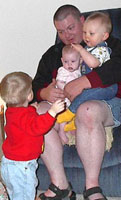

It's never been easy for working mothers, but there have never been so many mothers working. In the 1950s, less than one-fourth of mothers with young children worked. Now, two-thirds of mothers are employed. So why does it seem that working mothers are still an aberration? It may have to do with our conditioning.
THE OZZIE AND HARRIET "IDEAL"
"There is some consensus that the ideal situation is for a child to be taken care of full time by the mother," saysRosalind Barnett, Ph.D., a clinical psychologiststudying the roles of women in the family and the workplace. "But this so-called ideal is really just aninvention of the middle class from the relatively recentpast--mostly from TV shows of the 1950s, like OZZIEAND HARRIET.
"What's a full-time mother going to do with a child allday?" asks Barnett. "Data show that women at homeare vulnerable to depression and anxiety, and thatemployed women do better with stress and mentalhealth."
Barnett's viewpoints are borne out in a federallyfunded, four-year study of 300 couples reported in herbook, co-authored with Caryl Rivers, SHE WORKS/HEWORKS: HOW TWO-INCOME FAMILIES ARE HAPPIER,HEALTHIER AND BETTER OFF (Harper San Francisco,1996).The study found: Children of two-career couples are doing well.Maternal employment has no uniform effect on childdevelopment.Working mothers are physically healthier than thosewho stay at home.
Working mothers are less depressed than those whostay at home because work offers heightenedself-esteem and enhances mental health.
JOB INSECURITY Nevertheless, many working mothers still strugglewith their decision to work while their children are inday care. Here's one local voice: "I was back in the office about five weeks after givingbirth," says Shelley Young, marketing director of theSan Diego Ice Arena and mother of a two-year-olddaughter. "At first I took Madison with me for some ofthe shifts, but it got to be impossible. I felt I was at riskof losing my job so I had to put her in day care. I felt terrible about it, but my husband and I considered allthe options. We had a mortgage payment and decidedwe didn't want to give up a house we had just bought.This was our decision, and we try not to feel guiltyabout it."
Working women are made to feel guilty that they are neglecting their children if they aren't watching themfull time, says Joan Peters, author of WHEN MOTHERSWORK: LOVING OUR CHILDREN WITHOUT SACRIFICING OUR SELVES (Addison-Wesley, 1997). The added twist,according to Peters, "is that if working mothers enjoy their high-paying, powerful jobs, they are whores working for pleasure at the expense of their families."
Peters believes that women should work outside thehome. Her book suggests that when women swap theirwork identity for full-time motherhood, they putthemselves emotionally at risk, both for depression andfor projecting their need to achieve onto their children.
"Children do not require their parents to be with them24 hours a day," says Peters, a journalist and mother ofa six-year-old daughter. "It puts too much pressure onone person and leaves children at the emotional mercyof one person's moods, stresses and way of relating."
IS DAY CARE DETRIMENTAL? The debate about the benefits or hazards of other-carearrangements has been the subject of numerousstudies. According to experts, about half the studies show that children are harmed in some psychological way by not spending the early years with their mothers, while the other half show that children inother-care arrangements benefit from multiple caregivers.Several studies, however, have found no differences between the two groups, and these are the ones thatinterest Lori Roggman, Ph.D., associate professor atUtah State University in the department of family andhuman development. Unfortunately, says Roggman, these studies do not usually get published because editors think the results are too boring. She discovered 13 such studies, and firmly believes there are many more.
The unpublished reports found that attachmentto the mother is just as strong if the baby is in day careor at home with the mother.

Roggman says that about 65 percent of children aroundthe world are securely attached to their mothers--whether they are in day care or at home withtheir own mothers. "The big predictor of attachment issensitive, consistent caregiving that's responsive to thebaby's needs," she says. But no matter how securely bonded the child is to theworking mother, if the woman's employer doesn'tsupport her role as a mother, her life can be miserable.The linchpin to this entire debate is the role ofenlightened companies that encourage their staffs tobalance work and family. Not all companies do--especially when it comes to mothers taking timeoff to care for their sick children.
Ellen Bravo, co-director of the 9 to 5 NationalAssociation of Working Women, says a typical call to the organization's hotline is a woman wedged betweena day-care center refusing to accept her sick child and acompany that is threatening to fire her if she doesn'tshow up for work. "Moms do work outside the home," says Bravo, authorof THE JOB/FAMILY CHALLENGE: NOT FOR WOMENONLY (John Wiley & Sons, 1995). "Let's let them do itwithout jeopardizing their children. Our society isschizophrenic. Welfare mothers who stay at home withtheir children are viewed as lazy role models. On theother hand, if you have money and your husband has agood job, like the mother in the nanny trail, the reaction is that you should stay home."
Most mothers who stay at home were working women who decided they couldn't have it all--not at the same time. They're the ones who believe in "sequencing," or staying at home for the preschool years, then returning to work after their children are in school.
ON THE HOME FRONT"I was working as a television reporter with a weeklyprogram that I produced and hosted," says CatherineRogers, now a stay-at-home mother with twochildren, ages two and three. "I really liked the job, butbegan to feel the strain. I hated rushing my daughter tothe sitter, rushing home to nurse her on time, andfeeling like I was constantly beating the clock. The solution was to leave my job toward the end of my second pregnancy and to concentrate on my children.It's been a very enriching experience for me. I wouldfeel like I'm missing out if I wasn't there for my kids." Today, Rogers works on a volunteer basis as the publicrelations director for F.E.M.A.L.E., Formerly Employed Women at the Leading Edge, an organization that supports mothers who take time off from their careers to raise children.

Despite all the current focus on working women,statistics show that mothers still account for thefull-time care of about 53 percent of children youngerthan five--50 percent by nonemployed mothers and 3percent by mothers who run home-based businesses,according to 1996 U.S. census figures. When you add inchildren who are cared for by both parents in atag-team care arrangement and children who are inthe care of relatives, you find that 75 percent of youngchildren in the United States are cared for by a mother,father or other relative.
The nation's greatest concern probably centers aroundthe 25 percent of children younger than five who arecared for by nonfamily members: 15 percent are in daycare, 8 percent go to in-home day care and 2.4 percenthave a nanny. Stay-at-home mothers firmly believe they can care fortheir children better than day-care centers, and theyrefer to recent studies to prove their point. StanleyGreenspan, M.D., clinical professor of psychiatry andpediatrics at George Washington University MedicalSchool, recently wrote an article in the WashingtonPost that blasted day-care centers. He cited studiesconcluding that more than 80 percent of day care inchild-care centers is inadequate; and that for infants,out-of-home care, especially in day-care centers, tendsto be inferior to parental care.
A 1997 study from the Bush Center for ChildDevelopment and Social Policy at Yale Universityreviewed center-based infant and toddler care acrossthe country, and found that not one state met thefederally recommended standards of quality withregard to group composition, staff training andprogram of care. These studies validate the decision of mothers to stayat home, says Marian Gormley, a mother ofeight-year-old twins who works from home as thepublic relations director of Mothers at Home. Almosthalf the organization's members work part-time andmany plan to resume working.
"The group was founded to counter the view that it isdetrimental for mothers to leave their work to raisetheir children," says Gormley. "One of our messages isthat the choice to be home is possible and rewarding."
But mothers on both sides of the fence have learnedthat it doesn't pay to pit themselves against each other. Instead, many have begun to rally around one centralmessage: "We need more support for shared childrearing!" It seems that message is starting to get heard:President Clinton has proposed a major initiative tohelp working families obtain child care with a varietyof subsidies and tax breaks.
In the meantime, society will continue to ponder its great social experiment where, for the first time, an entire generation of children is being raised by mothers earning a paycheck. The true outcome of the decision towork or stay at home won't be evident for at least another 20 years--when these children become adults.
HOW FATHERS FIGURE And what about the working dads?
The latest "revolution" in child-care circles is anemphasis on working fathers and their role in raisingchildren. Fathers are no longer allowed to hide behindthe traditional dimension of just being thebreadwinner--nor do most of them want that role.Working fathers are now expected to more fullyparticipate in raising their children, and most have tobecause they have working wives who just can't do it all.
James Levine, director of the Fatherhood Project at theFamilies and Work Institute and author of WORKINGFATHERS: NEW STRATEGIES FOR BALANCING WORKAND FAMILY (Addison-Wesley, 1997), says researchfrom the institute shows that more men are feelingmore conflict between work and family life thananybody would have thought. And more men want andneed to be connected to their children.
He points to a few highlights of research across achild's life cycle: At age six months, babies with actively involvedfathers score higher on the Bailey Test of Mental andMotor Development. At age three, children who were born prematurely butwhose fathers spend more time playing with themhave better cognitive outcomes.
Dad's involvement with their preschool and school-age children yields continuing dividends in intellectual and social development. In adolescence, dad's involvement reduces the risk ofdrug use, juvenile delinquency and teen pregnancy,while increasing the amount of education completedwhen children reach their early 20s.
"For different families, the work-family equation willbalance in different ways," he writes. "Yet for allfamilies, it will be a delicate balance, one that requiresthe interplay of men and women, companies andcommunities, each contributing to and benefiting fromthe search for workable solutions."
Kucenasfoti, Silvia. “Working Moms Vs. Stay-At-Home Moms.” SanDiego Parent. 1998 http://www.family.go.com/ 20 Oct. 1999